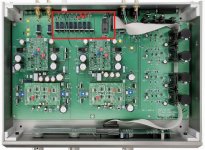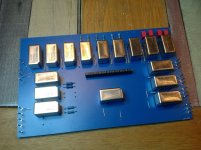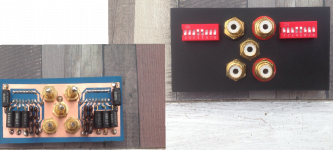Hi everyone,
I'm looking for a "easy" and simple to implement (no programming required) solution for cartridge loading/gain change on-the-fly without having the pop sound from dip-switch or relay switching. Loading and gain adjustment will be a matter of paralleling resistors. A schematic will help a lot.
I'm looking for a "easy" and simple to implement (no programming required) solution for cartridge loading/gain change on-the-fly without having the pop sound from dip-switch or relay switching. Loading and gain adjustment will be a matter of paralleling resistors. A schematic will help a lot.
Last edited:
Maybe one of those photo actuated mosfet relays, like the H11F series or Toshiba TLP240? Bring the current up on the LED slowly, perhaps that would avoid a pop or click. However, the audio will be conducting through a SS device - so maybe sounds good in theory, but listening?
big MOSFETs will have a lot of stray, non-linear, capacitance I fear, the TLP240 has 30pF quoted off-capacitance of unspecified linearity. CMOS switches can have sub 1pF breakthrough off capacitance.Maybe one of those photo actuated mosfet relays, like the H11F series or Toshiba TLP240? Bring the current up on the LED slowly, perhaps that would avoid a pop or click. However, the audio will be conducting through a SS device - so maybe sounds good in theory, but listening?
This is a job for a CMOS analog switch, signal- or reed-relay I reckon. Put up with the clicks!
If you are switching load resistors on an MC input you will need to worry about the back emf rise time from the relays. Best way to fix this is to put a snubber from the switching transistor to ground to slow the rise time. When switching the relay on, slow the rise time through an RC network to the transistor base. Make sure there is a minimum load permanently across the input eg 470 ohms.
For capacitive load switching on MM type inputs, connect the capacitor to the input and the other end through a 10k resistor to ground. Then connect the relay contacts across the resistor- select the capacitor by shorting the resistor out. The same rise time/ fall time precautions mentioned above also apply.
Importantly, in both cases make sure the loop area of the connection from the switching transistor to the relay and back again is as small as possible. This is critically important in order to minimize radiated noise from the fast switching edges (even after you’ve taken steps to slow them down). One approach is to mount the switching transistors right next to the relay coils - same with snubbers as well.
I have zero switching clicks or plops on my line level inputs since taking the above precautions with volume turned up full and changing preamp input selection and muting
For capacitive load switching on MM type inputs, connect the capacitor to the input and the other end through a 10k resistor to ground. Then connect the relay contacts across the resistor- select the capacitor by shorting the resistor out. The same rise time/ fall time precautions mentioned above also apply.
Importantly, in both cases make sure the loop area of the connection from the switching transistor to the relay and back again is as small as possible. This is critically important in order to minimize radiated noise from the fast switching edges (even after you’ve taken steps to slow them down). One approach is to mount the switching transistors right next to the relay coils - same with snubbers as well.
I have zero switching clicks or plops on my line level inputs since taking the above precautions with volume turned up full and changing preamp input selection and muting
Last edited:
If you are switching load resistors on an MC input you will need to worry about the back emf rise time from the relays. Best way to fix this is to put a snubber from the switching transistor to ground to slow the rise time. When switching the relay on, slow the rise time through an RC network to the transistor base. Make sure there is a minimum load permanently across the input eg 470 ohms.
For capacitive load switching on MM type inputs, connect the capacitor to the input and the other end through a 10k resistor to ground. Then connect the relay contacts across the resistor- select the capacitor by shorting the resistor out. The same rise time/ fall time precautions mentioned above also apply.
Importantly, in both cases make sure the loop area of the connection from the switching transistor to the relay and back again is as small as possible. This is critically important in order to minimize radiated noise from the fast switching edges (even after you’ve taken steps to slow them down). One approach is to mount the switching transistors right next to the relay coils - same with snubbers as well.
I have zero switching clicks or plops on my line level inputs since taking the above precautions with volume turned up full and changing preamp input selection and muting
Many thanks for explanation Andrew.
Build a paradise and use front mounted loading plugs, no pop or thump when you swap em
Are you sure there's no hum or buzz while your hand is holding the plug as it goes into the socket?
Have you actually tried that?
If you need to switch a cap or resistor you must have always connected one, p.e. 47 kohm, then with a switch or relays you can switch the others (in parallel ) on the fly.
You need to calculate exactly the values that will be connected in parallel for each position.
Same for cap, in this case the value increase.
Walter
You need to calculate exactly the values that will be connected in parallel for each position.
Same for cap, in this case the value increase.
Walter
Hi everyone,
I'm looking for a "easy" and simple to implement (no programming required) solution for cartridge loading/gain change on-the-fly without having the pop sound from dip-switch or relay switching. Loading and gain adjustment will be a matter of paralleling resistors. A schematic will help a lot.
Can't help you with gain adjustment but if you want to play with cart loading:
* simply buy a pair of RCA 'T' connectors,
* insert them into your phono stage RCA input sockets
* then put each phono cable into one of the T inputs
* and a 'loaded' plug into the other input.
The resistors in these loaded plugs act in parallel with the default 47K and produce, basically, a load equal to what the res value is.
Then when you've found the load value you like, for a little increase in SQ (by removing a connection), you can remove the 'T' connectors, and:
1. add a pair of RCA input sockets, in parallel with the original ones, for the load resistors or
2. change the default 47K res to your chosen value.
Are you sure there's no hum or buzz while your hand is holding the plug as it goes into the socket?
Have you actually tried that?
Yes, ray - absolutely no hum ... in my Muse phono stage, at least.
Andy
Hi everyone,
I'm looking for a "easy" and simple to implement (no programming required) solution for cartridge loading/gain change on-the-fly without having the pop sound from dip-switch or relay switching. Loading and gain adjustment will be a matter of paralleling resistors. A schematic will help a lot.
You always need a switch or relay for cartridge loading. For gain adjust you need changing thr phono preamp gain.
So my questions are is it for mc and/or mm? with whitch preamp? and must it be remote controll?
Attachments
Last edited:
Use a pot. or a make before break switched attenuator.
Attachments
Text not posted for some reason:
For some reason my text did not post propoerly.
As per Billshurv proposal, replace R105 with variable resistor.
Capacitive loading solution is from Denon PRA-1100
Using varicap for capacitive loading. Continously variable using pot-meter.
For some reason my text did not post propoerly.
As per Billshurv proposal, replace R105 with variable resistor.
Capacitive loading solution is from Denon PRA-1100
Using varicap for capacitive loading. Continously variable using pot-meter.
You always need a switch or relay for cartridge loading.
You're not thinking, mate! 😀
The way I provide variable loading for my 'Muse' phono stage is use parallel pairs of input RCA sockets, into which 'R-loaded' or 'C-loaded' plugs can be inserted. These then act in parallel with the default 47K & 100pF on the circuit board.
See pic of a dual MC/MM phono stage I made for someone recently.
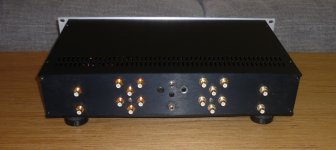
As per Billshurv proposal, replace R105 with variable resistor.
The trouble with a variable resistor is ... you can't be sure (without going to the extent of measuring, after you change the load) that both channels have exactly the same value of resistance.
Andy
Last edited:
I thought the OP wanted to change the loading on the fly? To me that says remotely via relays or with a rotary switch from the front panel. Adding DIP switches to change loading has been done for years.
You always need a switch or relay for cartridge loading. For gain adjust you need changing thr phono preamp gain.
So my questions are is it for mc and/or mm? with whitch preamp? and must it be remote controll?
Hi Ronny, I already built the phono preamp with switches. It's a MM/MC with adjustable gain (47-50-54-60dB). It is inspired from Allen Wright hybrid JFet/Tube in cascode configuration. It works flawlessly with DIP switches and since I found the sweet spot for my cartridge, I am not adjusting anymore. I was looking for on-the-fly method so I can implement it on my future projects.
That remote control with display looks interesting. Is it arduino?
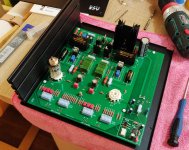
- Home
- Source & Line
- Analogue Source
- Change cartridge loading on-the-fly
